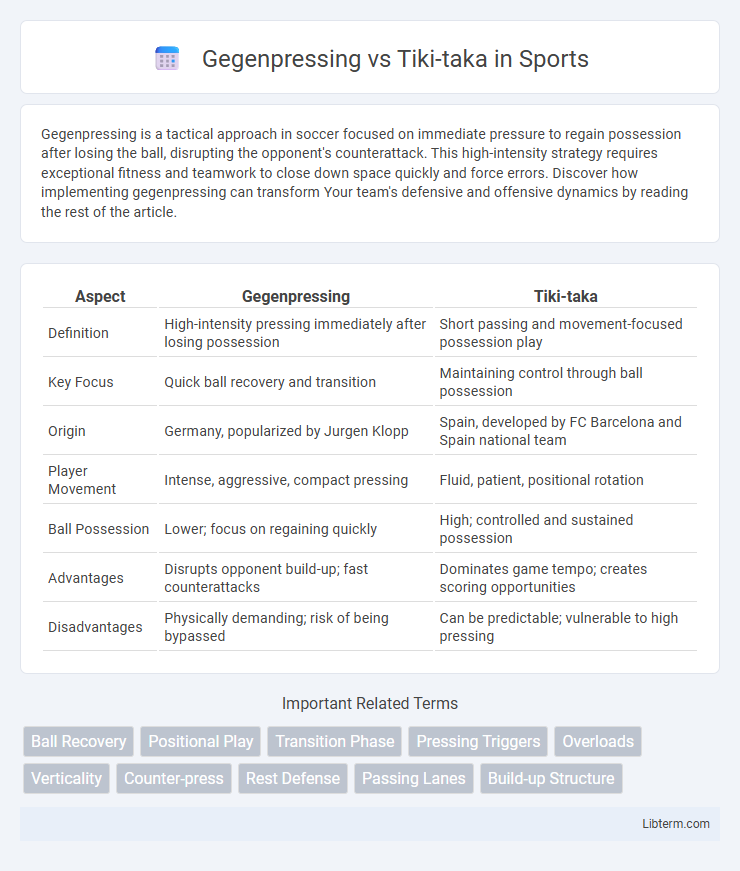Gegenpressing is a tactical approach in soccer focused on immediate pressure to regain possession after losing the ball, disrupting the opponent's counterattack. This high-intensity strategy requires exceptional fitness and teamwork to close down space quickly and force errors. Discover how implementing gegenpressing can transform Your team's defensive and offensive dynamics by reading the rest of the article.
Table of Comparison
| Aspect | Gegenpressing | Tiki-taka |
|---|---|---|
| Definition | High-intensity pressing immediately after losing possession | Short passing and movement-focused possession play |
| Key Focus | Quick ball recovery and transition | Maintaining control through ball possession |
| Origin | Germany, popularized by Jurgen Klopp | Spain, developed by FC Barcelona and Spain national team |
| Player Movement | Intense, aggressive, compact pressing | Fluid, patient, positional rotation |
| Ball Possession | Lower; focus on regaining quickly | High; controlled and sustained possession |
| Advantages | Disrupts opponent build-up; fast counterattacks | Dominates game tempo; creates scoring opportunities |
| Disadvantages | Physically demanding; risk of being bypassed | Can be predictable; vulnerable to high pressing |
Introduction to Gegenpressing and Tiki-taka
Gegenpressing is a high-intensity football strategy focused on immediate ball recovery through aggressive pressing right after losing possession, emphasizing quick transitions and collective team effort. Tiki-taka prioritizes maintaining possession with short, precise passes and patient build-up play, aiming to control the game's tempo and create scoring opportunities through spatial awareness. Both styles reflect contrasting tactical philosophies, with Gegenpressing centered on disruption and rapid counter-attacks, while Tiki-taka relies on dominating possession and methodical playmaking.
Historical Origins and Evolution
Gegenpressing originated in German football during the late 20th century, popularized by coaches like Ralf Rangnick and Jurgen Klopp, emphasizing immediate high-pressure counter-attacks after losing possession. Tiki-taka evolved from Spanish football, particularly the influence of Johan Cruyff's possession-based style at FC Barcelona in the 1990s, later refined under Pep Guardiola's management to focus on short passes and sustained ball control. Both styles represent distinct tactical evolutions rooted in their respective football cultures, shaping modern team strategies globally.
Core Principles of Gegenpressing
Gegenpressing centers on immediate high-intensity pressure to regain possession quickly after losing the ball, disrupting the opponent's build-up and forcing errors. It emphasizes teamwork, rapid transitions, and positional discipline to close down space aggressively in the attacking third. This approach contrasts with Tiki-taka, which relies on short passing and fluid possession control rather than intense counter-pressing.
Core Principles of Tiki-taka
Tiki-taka revolves around precise short passes and relentless ball possession to control the tempo and wear down opponents. Its core principles emphasize spatial awareness, quick player movement, and maintaining possession through intricate passing triangles. This style prioritizes technical skill and patience, contrasting with Gegenpressing's aggressive, immediate ball recovery strategy.
Key Tactical Differences
Gegenpressing emphasizes immediate high-intensity pressure to win the ball back quickly after losing possession, relying on aggressive, coordinated team movements to disrupt opponents' build-up play. Tiki-taka focuses on maintaining possession through short, precise passing and spatial control, creating scoring opportunities by patiently breaking down defenses. The key tactical difference lies in Gegenpressing's direct counter-pressing approach versus Tiki-taka's possession-based, patient build-up strategy.
Notable Managers and Teams
Gegenpressing, popularized by managers like Jurgen Klopp at Borussia Dortmund and Liverpool, emphasizes intense, high-energy pressing immediately after losing possession to quickly regain the ball. In contrast, Tiki-taka, famously perfected by Pep Guardiola at FC Barcelona, relies on short, precise passes and maintaining possession to control the game and create scoring opportunities. Both styles have shaped modern football, with Klopp's Bayern Munich and Guardiola's Manchester City continuing to evolve these tactical philosophies at the highest level.
Strengths and Weaknesses Comparison
Gegenpressing excels in quickly regaining possession and disrupting opponent play through intense, coordinated high pressing, but its high physical demands can lead to player fatigue and vulnerability during counterattacks. Tiki-taka emphasizes precise short passes and maintaining possession, reducing opposition chances by controlling the game's tempo; however, it risks losing effectiveness against well-organized defenses and lacks direct attacking potency. Both styles require high tactical discipline, with Gegenpressing favoring aggressive transitions and Tiki-taka prioritizing patient build-up play.
Impact on Modern Football
Gegenpressing revolutionized modern football by emphasizing immediate high-intensity pressing after losing possession, disrupting opponents' build-up play and accelerating transitions. Tiki-taka, characterized by short passes and maintaining possession, influenced teams to prioritize spatial control and patient ball circulation, shaping tactical approaches focused on ball retention. The integration of these styles has driven teams to blend aggressive defense with intricate possession, elevating tactical complexity and physical demands in contemporary football.
Famous Matches Showcasing Both Styles
The 2018 UEFA Champions League semifinal between Liverpool and Roma highlighted the intense effectiveness of gegenpressing, with Liverpool's rapid recovery of possession leading to crucial goals. Barcelona's 2011 UEFA Champions League final victory against Manchester United showcased tiki-taka's dominance through precise short passes and sustained ball control, overwhelming their opponents. These iconic matches underscore how gegenpressing's aggressive counter-pressing contrasts with tiki-taka's patient possession-based strategy, influencing modern football tactics worldwide.
Future Trends in Football Tactics
Future trends in football tactics emphasize the integration of Gegenpressing's high-intensity, immediate ball recovery with Tiki-taka's precision passing and spatial control to create dynamic, adaptable team strategies. Advanced player tracking and AI analytics are enhancing tactical decision-making, allowing teams to optimize transitions between Gegenpressing and possession-based play styles. Emerging hybrid systems prioritize versatility, physical endurance, and technical proficiency to meet evolving demands in top-level football competitions.
Gegenpressing Infographic

 libterm.com
libterm.com